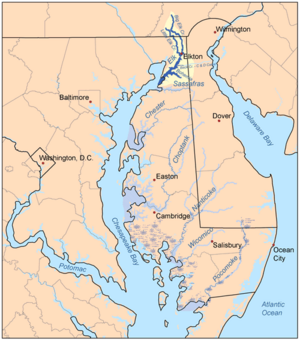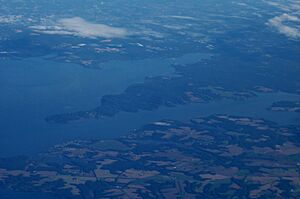Elk River (Maryland) facts for kids
The Elk River is a special kind of river called a tributary that flows into the Chesapeake Bay. It's located on the Eastern Shore of Maryland and at the top of the Delmarva Peninsula. The river is about 15 miles (24 km) long.
The Elk River is the most northeastern part of the Chesapeake Bay's estuary. An estuary is where fresh water from rivers mixes with salty ocean water. For a long time, since the 1800s, the Elk River has been an important entrance to the Chesapeake & Delaware Canal. This canal and the river now form one edge of the Elk Neck Peninsula. The river flows through Cecil County, Maryland. Its watershed, which is all the land where water drains into the river, also reaches into New Castle County, Delaware, and Chester County, Pennsylvania. The town of Elkton, which is the main town of Cecil County, is located at the very start of the river.
The Elk River's entire watershed covers about 143 square miles (370 km²), including the Bohemia River. About 21 square miles (54 km²) of this area is open water. This means about 15% of its watershed is water! The Elk River is found south and east of the North East River, and north of the Sassafras River.
Where the Elk River Flows
The Elk River starts in Elkton, Maryland. This is where two smaller streams, called Big Elk Creek and Little Elk Creek, join together. The river then flows all the way to the Chesapeake Bay. Its mouth, or opening, into the bay is about 1.4 miles (2.3 km) wide. This wide opening is between Turkey Point on Elk Neck and West View Shores / Sunset Point.
Little Elk Creek begins its journey near Oxford, Pennsylvania. The East Branch and West Branch of Big Elk Creek start a bit further south, near Cochranville, Pennsylvania. These creeks flow downhill through the Piedmont region of Pennsylvania and Maryland. The Piedmont is an area of rolling hills between the mountains and the flat coastal plain. They reach sea level when they get to Elkton. This spot is known as the "head of navigation" because it's as far as boats can easily travel up the river.
Smaller Rivers and Creeks
The Elk River has many smaller streams and creeks that flow into it. On the western side of the river, you'll find creeks like Muddy Creek, Jones Creek, Bull Minnow Run, and Plum Creek.
On the eastern side, there are some bigger waterways. One major tributary is Back Creek, which is now mostly part of the Chesapeake & Delaware Canal. Another important one is the Bohemia River. Smaller creeks on the eastern shore include Pearce Creek, Cabin John Creek, Herring Creek, and Perch Creek. All these smaller streams help feed water into the main Elk River.




